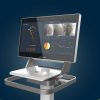At the beginning of the millennium, medtech companies enjoyed two-digit increases for several consecutive years. Although this phase may have come to an end, the medtech industry there is still promise in a number of areas: Suppliers continue to experience growth; R&D expenditures, in relation to sales, for example, is at 9% with respect to German medical technology companies (much higher than those in the chemical or processing industries); and finally, last year the medical technology sector submitted the highest number of patent applications, according to the European Patent Office.
More than 80% of MEDICA visitors are significantly involved in or provide professional consultation for purchasing decisions.For companies in the medical device industry, access to their customers has changed. Although they previously interfaced with physicians and hospital directors, today investments occur through purchasing networks or in large corporate hospital groups. Furthermore, a strong position is due to trade, through which suppliers are able realize their market presence in preferred countries. These factors introduce stronger competition and place more price pressures on suppliers.
Digitalization, Smart Technologies Continue to Progress
The digitalization of healthcare is moving forward at an unstoppable rate, affecting outpatient and clinical care, patients and physicians. With reference to Germany, the latest enacted E-health Act intends ensure that the networking of stakeholders within the scope of the healthcare process more effectively collect and use patient data.
Wearables, smartphones and mHealth apps are moving toward becoming an indispensable element of the future of networked health. At last year’s MEDICA, numerous new products were showcased, including a mobile 22-channel ECG system for tablet PCs and smartphones as well as an analysis tool for recording sleeping activity that provides a quality level virtually equal to that of sleep laboratories. Countless other mHealth apps are currently being developed, many of which focus on cardiovascular diseases and diabetes, as well as remote monitoring of therapies.
Big data, perhaps more appropriately called smart data, compiles and evaluates enormous amounts of patient data in order to gain knowledge about the development of and effective therapy for certain diseases. The biggest players in this new digital healthcare economy are Google, Apple, Microsoft and IBM. These companies are currently investing enormous sums, for example, in the development of artificial intelligence, which can be applied to the R&D of algorithms for automated image analysis. In the field of stroke, one promising solution intends to enable the professional expertise of neurologists via the software-based assessment of CT images to provide faster decisions in the ER department when assessing suspected cases of stroke without the presence of a neurologist.The MEDICA ECON FORUM will address opportunities and consequences of healthcare digitalization. The forum (in hall 15), is jointly organized by the Techniker Krankenkasse (a German statutory health insurance company) and Messe Düsseldorf.
Third Dimension Finds Its Way into the OR
Advancements interventional procedures are particularly important, and in modern surgical procedures, an integrated approach is in demand; data generated from medical imaging flows into the controls of surgical assistance systems. They can also be generated during surgery by imaging systems directly available in the OR, ensuring that intervention can take place precisely and immediately. Progress in the field of endoscopy and instruments for minimally invasive surgery provide a great benefit.
Third dimension is increasingly finding its way into the OR. In the case of 3-D laparoscopy systems, two image sensors precise aligned with each other at the end of the endoscope to give the surgeon a realistic endoscopic 3-D image during a procedure. The spatial depiction helps the surgeon make an assessment of the anatomy and the use of instruments. For example, needles can be better perceived during saturation for a more precise and faster procedure.
COMPAMED and MEDICA 2016 | November 14–17 | 10:00 am–6:30 pm | Düsseldorf Fairgrounds, GermanyNearly 5,000 exhibitors will use the MEDICA 2016 to present a full range of new products, services and processes for use within the scope of outpatient and clinical care on more than 1.2 million square feet of booked floor space. Focuses of the MEDICA trade fair include: Electromedicine/medical technology (more than 2,500 exhibitors), laboratory technology/diagnostics, physiotherapy/orthopedic technology, commodities and consumables, information and communication technology, medical furniture and specialist furnishings for hospitals and physicians’ offices. The COMPAMED trade fair will be held concurrently with MEDICA. With 18,800 visitors last year, COMPAMED broke its record. This year, the event takes place from Monday to Thursday (in halls 8a and 8b), November 14–17. As in previous years, only one ticket is necessary to visit both MEDICA and COMPAMED.








